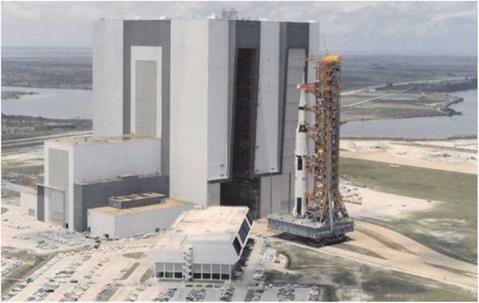Launch: a fiery departure
PREPARATIONS FOR LAUNCH Leaving the VAB
Final preparations for the launch of an Apollo mission began weeks in advance in one of the cavernous aisles of the 160-metre-tall vehicle assembly building (VAB). On a large steel platform, 49 by 40 metres, a complete but unfuelled Apollo/Saturn space vehicle, itself 110 metres tall, was stacked. ‘Space vehicle’ was a term for a combined launch vehicle and spacecraft. It started its journey when a 2,700-tonne diesel- powered crawler/transporter that employed tracked tractor units derived from heavy open-cast mining equipment jacked itself up underneath the platform and carried the combined load of 5,700 tonnes out through one of the massive doors and along a 5 V2 – kilometre crawlerway to one of two launch complexes, 39A or 39B, from which the rocket would make its fiery departure.
The crawler/transporter was one element of a mobile launch system that had been devised by members of Wernher von Braun’s rocket team. They had suggested that for a vehicle as large as an Apollo/Saturn V, the task of stacking its stages and installing the Apollo spacecraft on top would be best carried out inside a large hangar. The resulting VAB was a huge box-shaped building 52 storeys tall at the focus of Kennedy Space Center (KSC). In a sense, it was from here that a journey to the Moon began.
If the space vehicle had to be stacked indoors, a method had to be devised to get it out to the launch pad. Barges within dedicated canals were considered, as were great layouts of railway tracks, before the mobile launcher concept was decided. This called for a platform upon which the space vehicle would be fixed until the moment of launch. A tower even taller than the rocket sprouted from one end of the platform, which took the height of the whole affair to 136 metres. This launch umbilical tower (LUT) supplied the space vehicle with its essential services by way of nine huge arms that reached across from the tower. These tended the vehicle until they were swung away either prior to launch, or in some cases disconnecting and
W. D. Woods, How Apollo Flew to the Moon, Springer Praxis Books,
DOI 10.1007/978-1-4419-7179-1 3. © Springer Science+Business Media. LLC 2011
|
The Apollo 11 space vehicle leaving the YAB bound for Pad 39A. (NASA) |
pulling away only as the rocket began its flight. Though they weighed an average of 22 tonnes, these arms could quickly accelerate away from a rising rocket, and just as quickly brake to a halt close against the tower.
With the VAB doors open, the crawler/transporter lifted the platform clear of six supporting pillars and carted the entire assemblage away at about 1.5 kilometres per hour. To accommodate the pressure of the crawler’s 456 treads, each weighing nearly a tonne, a specialised roadway had to be constructed wherever it needed to go. A metre depth of support ballast fonned a bed for a layer of aggregate that bore the immense weight of the crawler and its load as they were steered along their journey to the launch pads.











